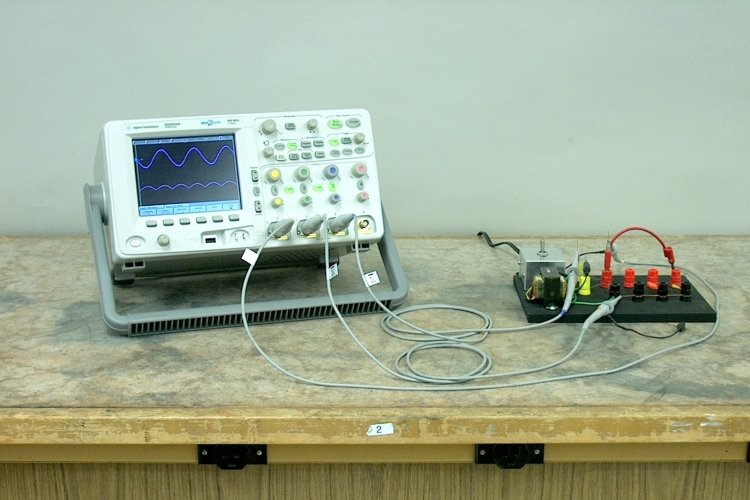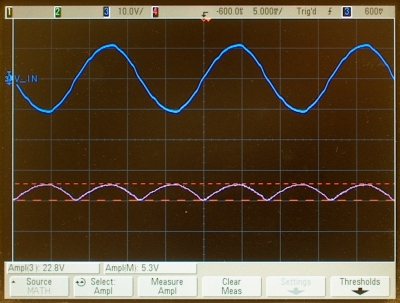

This demonstration is the next logical step from 64.57 -- Half-wave rectifier, in which the sinusoidal output of a function generator passes through a diode and a series resistor. This gives an output voltage that swings positive on the positive-going half-cycle and is zero during the negative-going half-cycle. In this demonstration, we use two diodes across the center-tapped secondary of a transformer to rectify both half cycles of the AC input. Since the transformer is a 6.3-volt filament transformer with a 110-volt primary, we use the wall voltage as our source. The schematic is below:

Scope channel three measures the voltage across the transformer secondary. Subtracting the voltage at channel two from that at channel one by means of the math function gives the voltage across the load. As in the half-wave rectifier, the diodes are 1N914, and the load is 100 kilohms. (Please note: The 1N914 is NOT typically used in power rectifier circuits. It is, however, more than capable of handling the currents and voltages used in this demonstration (vide infra).) The jumper (curved wire) allows you to add any of the three capacitors to the circuit for filtering (vide infra).
Both sides of the secondary swing both positive and negative with respect to the center tap on alternate half-cycles. The two diodes therefore conduct on alternate half cycles, as is visible in the photograph above. Since the potential between the center tap and each side of the transformer is half the potential across the secondary, the resulting amplitude of the rectified waveform is half that of the waveform that appears across the secondary. The enlarged photograph below shows this more clearly.

The peak-to-peak voltage of the input signal is 22.8 volts. One-quarter of this (half the peak voltage) would be 5.7 volts. Because of the junction potential, as mentioned in the pages for the LED and half-wave rectifier demonstrations, the measured amplitude of the bottom trace is 5.3 volts, about 0.4 volts lower.
As for the half-wave rectifier, in order to change the rectified voltage from a pulsating DC voltage to a steady one, we can place a capacitor across the load. The capacitor charges during the positive-going part of each half-cycle, and it discharges through the load during the negative-going part. Depending on the RC time constant (see demonstrations 64.51 -- RC circuit to galvanometer and 64.54 -- RC circuit to oscilloscope), the discharge takes more or less of the time between peaks, and the filtering action flattens the output voltage to a greater or lesser extent. The three photographs below show the result of adding each of the three capacitors on the circuit board:
We see that the filtering afforded by the 0.01-μf capacitor raises the tail of each half-cycle, the 0.1-μf capacitor smooths the waveform even more, leaving a noticeable ripple, and the 10-μf capacitor takes out enough of the ripple to make the DC voltage essentially flat. For these photographs, the scales for channel three and the math channel were equal, to show the relative amplitudes of the wave forms. You can, of course, choose a lower scale for the math channel to magnify the trace and show the ripple more clearly.
As the text for the half-wave rectifier demonstration states, for a given rectifier circuit, the size of the ripple can be expressed as the “ripple factor,” r = Iac/Idc = Vac/Vdc. r also equals 1/(2√3fCRL), where f is the frequency of the ac component. As we can see from the traces above, for the full-wave rectifier the frequency equals twice that of the input voltage. Since the frequency of the input is 60 Hz, the ripple frequency is 120 Hz. This expression holds only for wave forms that are approximately sinusoidal, and for loads that do not cause the output voltage to drop more than about 20% from the peak voltage. Alternatively, we can derive a simple expression for the ripple voltage. If the ripple is small, we can assume that the current through the load is constant, and from I = C(dV/dt) we have ΔV = (I/C)Δt. Δt is just the period of the ripple, so it equals 1/f, making the expression ΔV = (Iload/fC). (Here, f is double the line frequency, or 120 Hz, as mentioned above.) In doing this, we have assumed a linear discharge of the capacitor, instead of an exponential, but for constant load current, the discharge is linear. We can see from both of these expressions that for a given frequency, increasing the capacitance reduces the magnitude of the ripple, and whatever the capacitance, increasing the frequency of oscillation of the input voltage also decreases the size of the ripple. We can also see from the first two traces above that as the ripple becomes smaller, the discharge gets closer to being linear.
As the text for the half-wave rectifier demonstration also states, the diodes used in a rectifier circuit must have the proper ratings so that they will not fail. The main considerations for a rectifier circuit are the maximum average forward current and the peak inverse voltage (PIV), or maximum repetitive reverse voltage (VRRM). The maximum average forward current is roughly 1/2(Vav/RL), where Vav is the average voltage and RL is the load resistance, since each diode conducts only half the time. As for the half-wave rectifier, if we add a capacitor to filter the output, the PIV is twice the peak voltage, but in this case, the peak voltage is half the 11.4 volts peak across the secondary, or 5.7 volts. The capacitor holds the output at the peak voltage, 5.7 volts in this demonstration, while the anode of each diode swings down to minus the peak voltage, or -5.7 volts, so the diode must be able to handle a PIV of 11.4 volts. The 1N914 diodes used in this demonstration are rated for a VRRM of 100 volts and an average rectified forward current of 200 mA. While these values, especially the average forward current, make these diodes unsuitable for use in most power supply applications, they easily handle the PIV of 11.4 volts and average forward current of 53 μA present in this demonstration.
References:
1) Howard V. Malmstadt, Christie G. Enke and Stanley R. Crouch. Electronics and Instrumentation for Scientists (Menlo Park, California: The Benjamin/Cummings Publishing Company, Inc., 1981), pp.58-59, 61-62.
2) Paul Horowitz and Winfield Hill. The Art of Electronics, Second Edition (New York: Cambridge University Press, 1994), pp. 45-46, 329-330.
3) Fairchild Semiconductor Corporation. Data Sheet for 1N/FDLL 914/A/B / 916/A/B / 4148 / 4448 Small Signal Diode (2002).